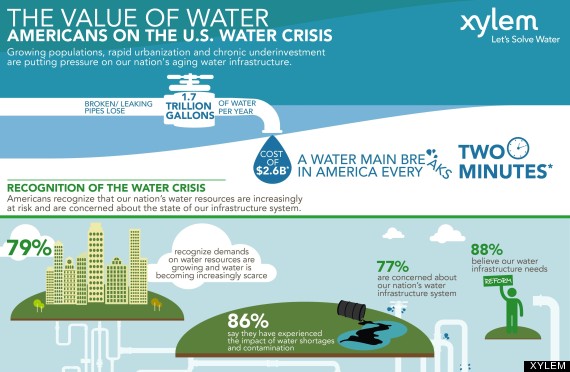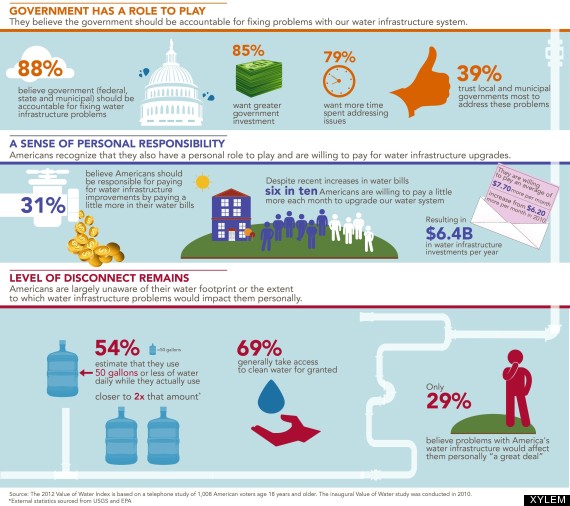Hidden underground, the deterioration of our nation's water pipes and treatment systems has gone largely unnoticed. But as the recent devastation from Hurricane Sandy has made tragically visible, our country's water infrastructure is in critical need of greater investments and modernization. And what better time to revitalize our infrastructure than now, in the wake of this month's elections -- with a second administration for the President and a new Congress on the way? Let's take advantage of this moment to solve our water infrastructure challenges and protect a vital natural resource while there is a heightened sense of urgency about both our economic future and the fundamental safety of our people.
At Xylem, a global water technology company headquartered in White Plains, New York, we believe it is essential that a new consciousness be instilled that will fundamentally change how we interact with water throughout this country. The simple act of turning on a faucet must trigger a new awareness that something very valuable is being utilized.
As part of our effort to change mindsets and encourage action, we developed the Value of Water Index to determine exactly what people think about water and our nation's water infrastructure. We have learned that people are concerned about their community water supply, want government involved and would be willing to pay an additional amount of money to improve the country's water infrastructure system and ensure long-term access to water.
Having established a baseline to assess attitudes toward water in 2010, we conducted a second Value of Water Index this fall and telephone polled 1,008 American voters, age 18 years and older.
While we covered many of the same issues as the original poll, this year we also decided to explore three new areas: personal impact of water infrastructure issues, understanding cost drivers and value both on an individual and community level, and personal responsibility for water infrastructure maintenance and advocacy. We focused on these themes because it has become apparent that water policy in this country has a "head and heart" challenge.

The first poll revealed that people, in substantial numbers, recognized the essential importance of water and understood that governments, businesses and individuals all had significant roles to play in addressing water challenges. While water had clearly become an important policy priority to them, we also wanted to determine whether there was sufficiently strong emotional support to drive personal and political behavior. If people deeply care about water, they will make a greater effort to conserve it and will insist that their elected and corporate leaders place a greater priority on improving our nation's water infrastructure systems.
Let's start with the good news. This year's Value of Water Index found that nearly all Americans consider water an important service on par with electricity and heat and three-quarters of Americans are concerned about the state of our nation's water infrastructure systems. The percentage of Americans that perceive our water infrastructure as a top infrastructure priority has nearly doubled since 2010 and they say it is as important as our nation's roads. People also said that despite the recent water rates increase, 61 percent are willing to pay more money to underwrite infrastructure improvements, and the amount they are willing to pay has increased by nearly 25 percent since 2010. If we took them up on their offer, for about the cost of four bottles of water per month per household, the United States could invest an additional $6.4 billion per year to maintain our nation's water infrastructure. This is more than six times the current federal investment in our nation's drinking water systems through the U.S. EPA Drinking Water State Revolving Fund, the main vessel for federal water infrastructure funding. Additionally, according to the American Water Works Association (AWWA), for every $10 billion spent on water-related projects, an additional 400,000 jobs could be created.
Yet, here is our dilemma: While the majority of Americans support strengthening water infrastructure throughout the country and have expressed a willingness to pay more for improvements, our 2012 Value of Water Index also reveals that few people have made an effort to truly understand the real problems. Their reported answers reveal little insight into the factors impacting water costs; they do not recognize their water footprint (most people believe they use 50 gallons or less daily when it is really closer to 100 gallons) or how water infrastructure problems would affect them personally. Regrettably, the percentage of Americans believing that water infrastructure problems would affect them "a great deal" has fallen significantly since 2010, dropping from 41 percent in 2010 to 29 percent in 2012.
This disconnect must be addressed. We have to increase Americans' understanding of the vital role water plays in our lives and underscore the need for strong and reliable water infrastructure to protect our economic future. Changing mindsets and creating a rationale for action will require an aggressive "head and heart" campaign. And there is no better time than now.
The water industry must work together to make a comprehensive case for greater society collaboration, increased investments, the development of intelligent and energy efficient products, and perhaps most importantly, an appetite for new responsibilities. We need to call on thought leaders and our communities to start thinking about what our water infrastructure of tomorrow could -- and should -- look like. And we need to enhance public recognition that while it is going to take time and money to drive and to implement change, the cost of not doing anything is even higher in the long run.
Ultimately, campaigns designed to achieve this level of change only work if people understand the issue. The question is: When, as a society, will we finally come to understand that water is truly a precious commodity and, armed with that understanding, when will we take action to ensure that water is protected not only for today, but for generations to come?
